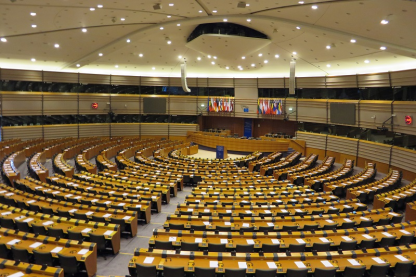This article is part of our Brexiting collection:
 Theresa May has been asked many times about the negotiation stance she and her government will adopt for Brexit. One of the concerns for many is that the government is adopting a hard-line, all-or-nothing approach, suggesting that “No deal better is than a bad deal” in the hope that the EU will cave in to British demands. Looking at the psychology of negotiation this approach cannot be expected to produce the economic outcome most people want: continued access to the single market without major disruption to the British economy. Even before negotiation has started, the spat between Theresa May and Jean-Claude Juncker suggests that the dynamic is oppositional, competitive and antagonistic. In other words the starting conditions for the Brexit negotiations are already strained.
Theresa May has been asked many times about the negotiation stance she and her government will adopt for Brexit. One of the concerns for many is that the government is adopting a hard-line, all-or-nothing approach, suggesting that “No deal better is than a bad deal” in the hope that the EU will cave in to British demands. Looking at the psychology of negotiation this approach cannot be expected to produce the economic outcome most people want: continued access to the single market without major disruption to the British economy. Even before negotiation has started, the spat between Theresa May and Jean-Claude Juncker suggests that the dynamic is oppositional, competitive and antagonistic. In other words the starting conditions for the Brexit negotiations are already strained.
Psychologists have gained considerable understanding of negotiation processes, particularly the conditions under which they succeed and under which they break down. One of the most important requirements to successful negotiation is the adoption of a win-win strategy.
A win-win strategy involving ‘Win-win’ bargaining means finding a common ground in which all parties in the negotiation process can leave the negotiation satisfied with having gained their overall objectives. In contrast, a win-lose strategy means one negotiating party seeks to maximise its gains at the expense of losses on the other side. In other words, the one party is satisfied at the expense of the other. Finally, there are some situation in which only a lose/lose strategy is possible. Here all parties accept that losses will occur and the only thing to negotiate over is how the losses will be distributed with each party seeking to minimise its losses.
We can see the win-lose dynamic in the trade-off between access to the single market desired by the UK and the core principles of the single market are the so-called “four freedoms”: free movement of goods, capital, services, and labour. The free movement of labour is what underpins many of the rights allowing the citizens of other European countries to live and work in the UK, and what allows UK citizens to live and work in Europe. But – importantly – the EU is currently arguing that these four freedoms are indivisible; the UK cannot have free movement of goods, capital and services without accepting free movement of labour.
A large part of the Brexit campaign was fought around immigration, and as a result accepting free movement of labour will be strongly resisted by anti-immigration factions in Theresa May’s government, but also in other parties, the media and the wider UK population. The perception of this issue as a ‘lose’ condition means that it is likely to be contentious in the negotiations.
Another issues likely to come to the fore is the sovereignty dispute with Spain over Gibraltar. The UK in the EU makes it simple for Gibraltar to be part of the free trade and movement agreement. However, once the UK has left, there are questions about its future. Gibraltar is situated in the south of the Spanish peninsula, it is subject to historic claims by Spain for its territory and has close economic relations with its much larger neighbour. How Gibraltar will be handled during the Brexit negotiation is unclear. Even with the best Brexit negotiation team in the world, a last minute veto by Spain could derail the whole agreement, irrespective of how the other 26 other countries of the EU view the deal.
While it is easy to understand that a win-win is a good strategy to follow, with Brexit it is becoming increasingly obvious that this will be extremely difficult to achieve in the time frame of the 2-year negotiation process. The danger is that Brexit negotiations will default to a lose-lose situation unless the common ground necessary for win-win can be found.
So what could be done to give the Brexit negotiations the best start? To begin with it is important to set the correct tone. This may involve suggesting that conversations from the past are put to one side, and that the UK makes the first move by unilaterally setting out a potential win-win strategy. How might this be done? It might involve agreeing in advance to separate the people negotiating from the problem being negotiated over. This can be achieved by avoiding escalatory personal behaviours that distract from discussion of the problem, such as by avoiding personal attacks or threats to storm out of meetings. Psychology helps here because success will require careful consideration of the personality style of the person in charge of negotiations.
Emphasising the discussion of facts and avoiding appeals to opinions and negotiators’ personal idiosyncrasies is a further way to avoid personalising the discussions. A focus on overall aims rather than current positions may help negotiators to overcome the hardening of camps that results in entrenchment and a failure to progress. This needs to be established as a principle for the negotiations by identifying the shared interests between the EU and UK, rather than by stating unilateral ideological positions and demands. While there may be aspects to the negotiations in which agreement cannot easily be reached, a focus on options for which agreement is possible is critical. This needs to present clear gains (for example spelling out what it means to have single market access for which level of EU labour migration).
When options cannot be agreed, the focus needs to shift onto the criteria that would make the options acceptable to all parties. If an option appears too costly to one side there needs to be a process of identifying the conditions under which it would be acceptable. For example, if totally free movement of labour is unacceptable, then perhaps movement of labour could be accepted where the person has already been offered a job of a certain standard, or in key industries.
The risks of a lose-lose outcome in Brexit negotiations lies in the issues being complex. At best, general principles for the orderly exit can be agreed but may lack sufficient detail on how they would be implemented. Psychologically the biggest threat to negotiations is that the UK and EU negotiation teams may be over-confident and feel entitled to have their way without considering all the options available. Under such conditions, the negotiations might break down despite the best efforts of the other side to try and make the negotiation process constructive and fair.




Rate and Review
Rate this article
Review this article
Log into OpenLearn to leave reviews and join in the conversation.
Article reviews